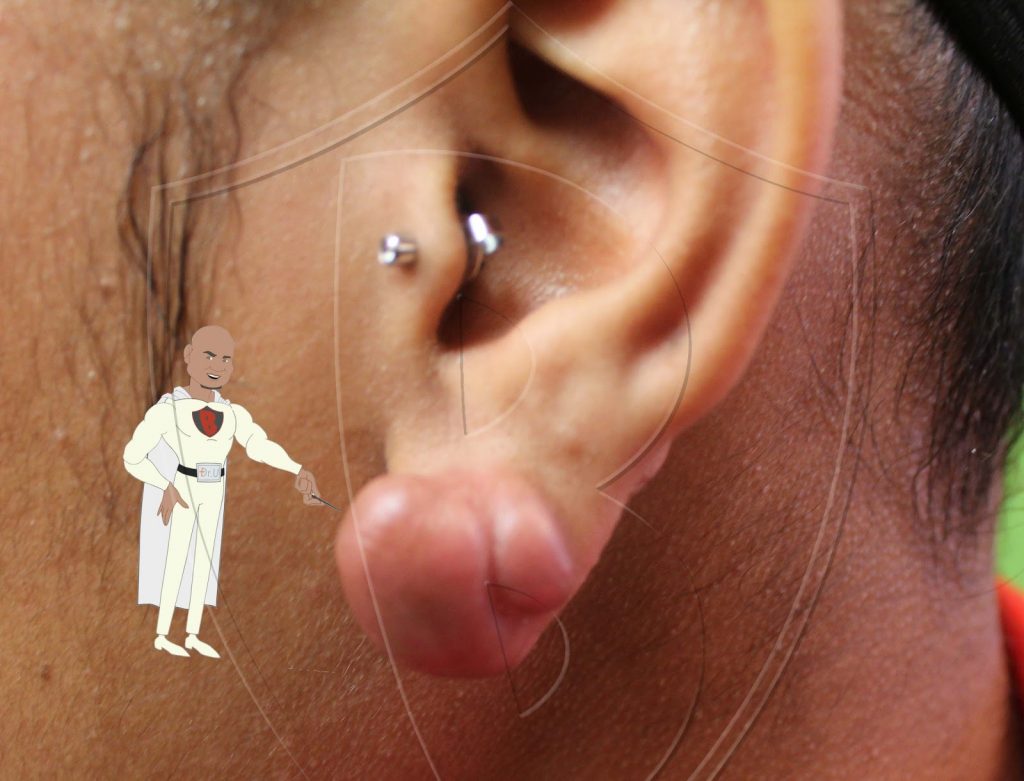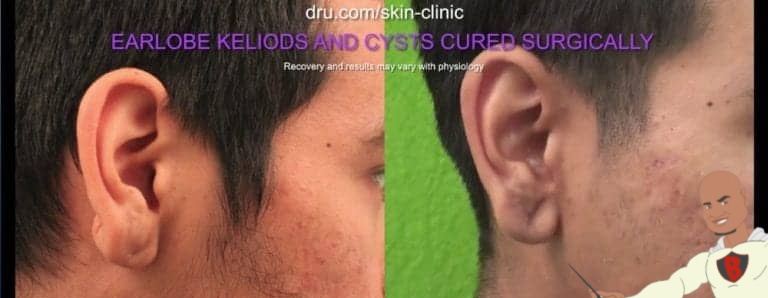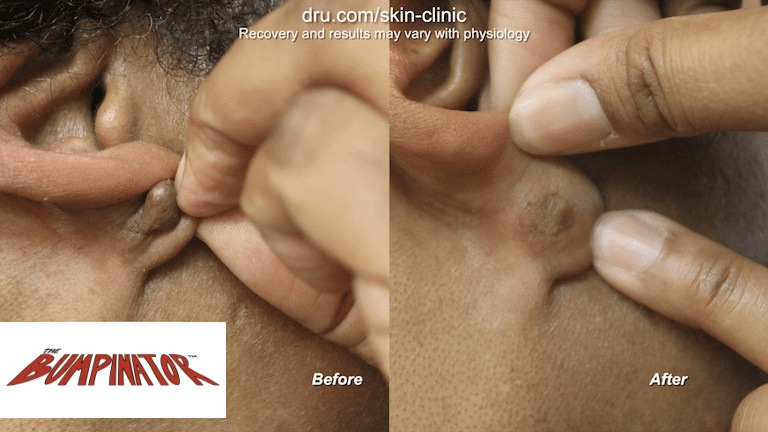Keloids are raised scars that primarily appear after trauma – a cut or wound. They’re firm, sometimes shiny, rubbery, and have fibrous nodules that are caused by the scar tissue. They range in sizes and in colors – pink, skin-colored, red, or dark brown.
What Is Keloidal Scarring?
As the body tries to repair the wound, there is a production of collagen. It’s the overproduction of collagen that forms a lump. Typically, keloids are also known as keloid disorder and keloidal scars can form in a variety of scenarios namely – severe acne, chickenpox scarring, infections, burns, vaccinations along tension during wound closure, or repeated trauma to the skin.

There have also been instances with something as simple as a pimple, mosquito bite, insect bite or a scratch can cause keloids. They appear on the chest, back, shoulders, earlobes, arms, pelvic region, and the collarbone. These types of keloids are not meant to be confused with Acne Keloidalis Nuchae, which has a different etiology.
How Do I Know if I Have a Keloid

Although injuries are attributed to the result of a keloid, they can appear spontaneously and prone to growth. Similarly, it can start as a small lesion on the skin and grow (slowly) with time (1). Keloids also tend to appear more so in the younger years, Dr. Sanusi Umar, also known as Dr. Bumpinator explained. Meaning that young girls between ages 10 and 20 have a higher frequency of keloids due to ear piercings.
Keloid symptoms include –
- Itchy, stinging, or burning sensations on the skin.
- There’s a ridged or bumpy area on the skin that’s unusually raised.
- The skin is toned red or pink in color.
- The scar tissue, in time, increases in size
- The keloid can be unsightly or uncomfortable.
A qualified medical professional can diagnose and treat keloids. Although medical attention is not necessary to treat keloid. They’re generally benign, but seeking medical attention as a precaution is not a bad idea.
Reasons To Get Keloids Removed
- Symptoms
- Aesthetics
- Size
- Ulceration
- Proximity and involvements of vital organs and functions
A keloid’s common area on the body includes – areas of high skin tension.
The Pierced Ear Keloid
Keloids are most common after ear piercing. The piercing itself causes a minor trauma on the earlobes in addition to the skin and cartilage higher on the ear. As the wound heals wider and larger than the initial pierced skin, it becomes uncomfortable and embarrassing too.
Because the way every person heals from wounds is different, the size of the developed keloid varies from person to person. This condition is commonly seen mostly among African Americans, Latinos, and Asians (1).
Ear keloids are broken down into three types (1) –
- Massive ear keloid: One keloid lesion measuring greater than 10 centimeters.
- Large and semi-massive ear keloid: One keloid lesion measuring 2.1-10 centimeters.
- Small ear keloids: One keloid lesion measuring no greater than 2 centimeters.
Removing Keloids
Conventional methods of keloid removal call for surgical removal, but according to research, almost all ear keloids will “relapse” after surgery (1). When those keloids grow back they get worse and with time even grow larger. Ultimately, “the ear keloids will continue to relapse in many instances and at some point, the surgeon and patient or both will abandon therapeutic intervention,” research documents show.
Dr. Bumpinator disagrees. “With the appropriate treatment,” Dr. Bumpinator said. “the lesions or keloids respond well and never return.”
For this to occur special surgical and post-surgical protocols are necessary. At Dr. U Hair and Skin Clinic in Manhattan Beach, he’s implemented a keloid removal procedure that helps prevent the keloid from returning. The guiding principle is to get rid of all keloid tissue while avoiding the expansion of the zone of injury by keeping all surgical injuries to within the original borders of the keloid, minimizing tension and reductive the wound created less need to form a scar in the bid to cover itself.
“I want my patients to be left with an aesthetically pleasing earlobe with fast recovery time.”
The following photos show examples of patients surgically treated by Dr Bumpinator using the espoused surgical principles:

Dr.Bumpinator is on a mission to terminate all unwanted skin bumps, including keloid scars! *


There are other (non-surgical) keloid removal options, including:
- Cryotherapy: Freezing of the keloid. This is the better option for smaller keloids, i.e. caused by acne. Risks lightening of the skin.
- Corticosteroids: Injection of medicine into the keloid. This is one of the most common approaches to remove keloids. It is also often used in conjunction with cryotherapy or post-surgery.
- Medication: Though not as effective as corticosteroids, other medications that have been used to treat keloids includes: verapamil, fluorouracil, bleomycin, and interferon alfa-2b shots.
- Radiation: Radiation of the Grenz zone, is the most effective if done within 24-72 hours after excisions. It is actually quite an effective treatment with a low chance of recurrence. Dr. Bumpinator uses this treatment option with more complicated wound closures.
Furthermore, Dr. Bumpinator’s unconventional method pushes for a keloid free patient who didn’t have a need for steroid injections.
Keloid Questions?
Dr. Bumpinator encourages anyone with a growth of a keloid on the ear or other parts of the body to consult with a medical professional. Ask your keloid questions at
[Button id=”5″]
FAQ – Understanding Keloidal Scarring
Who is a candidate for keloid removal? Any person with a keloid can be a candidate for keloid removal.
How much does a keloid removal cost? Cost varies and depends on the size of the keloid. In other instances, at other clinics, the cost may also depend on the location of the scar and the method the doctor decides to use. The average cost could range between $350 to $3500. Unfortunately, insurance doesn’t cover cosmetic procedures.
What keloid removal procedures are available for Dr. Bumpinator patients? Dr. Bumpinator, an expert in bumps, also has experience in keloid removal and offers individualized treatment plans. In order to determine your procedure or best removal method, schedule a consultation:
References –
- Tirgan, Michael. (2017). Massive ear keloids: Natural history, evaluation of risk factors and recommendation for preventive measures – A retrospective case series. F1000Research. 5. 2517. 10.12688/f1000research.9504.2.
Further Reading
Learn how Acne Keloidalis Nuchae can grow to become an enormous-sized bump